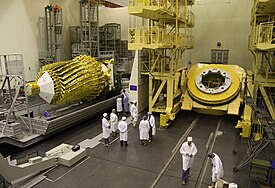RadioAstron

Spektr-R at the integration and test complex of Launch Pad No.31, the Baikonur Space Center in July 2011
|
|
| Names | RadioAstron |
|---|---|
| Mission type | Radio telescope |
| Operator | Russian Astro Space Center |
| COSPAR ID | 2011-037A |
| SATCAT no. | 37755 |
| Website | http://www.asc.rssi.ru/radioastron/ |
| Mission duration | Planned: 5 years Elapsed: 5 years, 7 months, 9 days |
| Spacecraft properties | |
| Bus | Navigator |
| Manufacturer | NPO Lavochkin |
| Launch mass | 3,660 kg (8,069 lb) |
| Payload mass | 2,500 kg (5,512 lb) |
| Start of mission | |
| Launch date | 18 July 2011, 02:31 UTC |
| Rocket | Zenit-3F |
| Launch site | Baikonur Cosmodrome Pad 45/1 |
| Contractor | Roscosmos |
| Orbital parameters | |
| Reference system | Geocentric |
| Regime | Highly elliptical |
| Semi-major axis | 180,974.7 km (112,452 mi) |
| Eccentricity | 0.905900 |
| Perigee | 10,651.6 km (6,619 mi) |
| Apogee | 338,541.5 km (210,360 mi) |
| Inclination | 42.46° |
| Period | 12769.93 min |
| RAAN | 67.28° |
| Argument of perigee | 244.85° |
| Mean anomaly | 3.07° |
| Mean motion | 0.1126 rev/day |
| Epoch | 24 February 2016, 23:21:29 UTC |
| Revolution no. | 197 |
| Main telescope | |
| Diameter | 10 m (33 ft) |
| Focal length | 4.22 m (13.8 ft) |
| Wavelengths | 92, 18, 6, 1.3 cm |
Spektr-R (or RadioAstron) is a Russian scientific satellite with a 10 m (33 ft) radio telescope on board. It was launched on 18 July 2011, by Zenit-3F launcher, from Baikonur Cosmodrome to perform research on the structure and dynamics of radio sources within and beyond our galaxy. Together with some of the largest ground-based radio telescopes, this telescope forms interferometric baselines extending up to 350,000 km (220,000 mi).
The Spektr-R project is funded by the Astro Space Center of Russia, and was launched into Earth orbit on 18 July 2011, with a perigee of 10,000 km (6,200 mi) and an apogee of 390,000 km (240,000 mi), about 700 times the orbital height of the Hubble Space Telescope at its highest point and 20 times at its lowest. In comparison, the average distance from Earth to the Moon is 384,400 km (238,900 mi).
The main scientific goal of the mission is the study of astronomical objects with an angular resolution up to a few millionths of an arcsecond. This is accomplished by using the satellite in conjunction with ground-based observatories and interferometry techniques. Another purpose of the project was to develop an understanding of fundamental issues of astrophysics and cosmology. This included star formations, the structure of galaxies, interstellar space, black holes and dark matter.
...
Wikipedia
